-
Paper Information
- Previous Paper
- Paper Submission
-
Journal Information
- About This Journal
- Editorial Board
- Current Issue
- Archive
- Author Guidelines
- Contact Us
International Journal of Agriculture and Forestry
p-ISSN: 2165-882X e-ISSN: 2165-8846
2017; 7(1): 13-22
doi:10.5923/j.ijaf.20170701.03

Risk Mitigation for Removal of Pesticide Residues in Curry Leaf for Food Safety
Priyadarshini G.1, Shashi Vemuri2, C. Narendra Reddy1, S. Swarupa2, K. Kavitha2
1Department of Entomology, Prof. Jayashankar Telangana State Agricultural University, Hyderabad, India
2All India Network Project on Pesticide Residues, Prof. Jayashankar Telangana State Agricultural University, Hyderabad, India
Correspondence to: Shashi Vemuri, All India Network Project on Pesticide Residues, Prof. Jayashankar Telangana State Agricultural University, Hyderabad, India.
| Email: |  |
Copyright © 2017 Scientific & Academic Publishing. All Rights Reserved.
This work is licensed under the Creative Commons Attribution International License (CC BY).
http://creativecommons.org/licenses/by/4.0/

The increased consumer awareness and legal issues on food safety with special reference to insecticide residues in foods, led to attempt for cheap and effective methods for removal of pesticide residues as the farmers are not following the Good Agricultural Practices. The most commonly used pesticides such as Profenofos, Triazophos, Ethion, Carbendazim, Chlorpyriphos and Cypermethrin were sprayed at recommended doses at vegetative stage and samples collected at 2 hours after treatment to quantify the deposits. The samples were subjected to various household treatments and analysed for residues using validated QuEChERS method, to estimate the percent removal and their effectiveness. For effective decontamination of all pesticides no single treatment was commonly effective, however the best household method for removal of pesticide residues were tap water wash and dipping in salt solution and also the method is effective in reducing the residues below MRL (Maximum Residue Limits).
Keywords: Pesticide Residues, Curryleaf, Food Safety, Risk Mitigation, MRL
Cite this paper: Priyadarshini G., Shashi Vemuri, C. Narendra Reddy, S. Swarupa, K. Kavitha, Risk Mitigation for Removal of Pesticide Residues in Curry Leaf for Food Safety, International Journal of Agriculture and Forestry, Vol. 7 No. 1, 2017, pp. 13-22. doi: 10.5923/j.ijaf.20170701.03.
1. Introduction
- Murraya koenigii L. (curry leaf) belonging to family Rutaceae is a leafy spice characterizing authentic Asian-Indian cuisine and it is used in small quantities for its distinct aroma as well as for preservation purposes., Curry leaf oil an volatile oil produced from the plant has uses in the soap industry (Salikutty and Peter, 2008). Recent studies have shown that carbazole alkaloids have several biological activities such as anti carcinogenic effects in dimethyl hydrazine (DMH) treated rats (Khanum et al., 2000), anti platelet activity and vaso relaxing effects (Wu et al., 1998). Chevalier (1996) also reported that curry leaf has medicinal value as traditionally used in Eastern Asia. Interest in greater use of curry leaf has been stimulated since its high antioxidant potency was reported and this antioxidant activity is attributed due to maha nimbine, murrayanol and mahanine from M. koenigii (Tachibana et al., 2003; Ningappa et al., 2008). Chowdhury et al. (2001) reported that these alkaloids have antimicrobial activity against gram positive and negative bacteria, and fungi. Lee et al. (2002) noted that enrichment of phenolic compounds within the plant extract is correlated with their enhanced antioxidant activity. It is reported to have antioxidant, anti-diabetic, anti carcinogenic, anti dysenteric stimulant, hypo glycaemic and anti microbial activities (Khanum et al., 2000). Biologically active carbazole alkaloids are reported to have anti microbial properties (Ramsewak et al., 1999). Curry leaves have been reported to contain tocopherol, b-carotene, lutein and alkaloids (Khanum et al., 2000). But it is observed that curry leaves have received red alert message from the European Union, the major importers, as the pesticide residue limits were found much beyond the permissible levels. Maximum Residue Limits (MRLs) are set by Codex Alimentarius Commission (CAC) at international level and as on date, no MRLs are set for any pesticides on curryleaf, and by Food Safety and Standards Authority of India (FSSAI) of Ministry of Health and Family Welfare, Government of India, as per Food Safety and Standards Act, 2006 at national level based on the Good Agricultural Practices. To control the major insect pest of curry leaf farmers apply insecticides at almost weekly interval, and hence the risk of pesticide residues in foods need to be addressed as per FSSAI (Food Safety and Standards Authority of India) for the protection of consumer health and interests. In this context, household risk mitigation methods for removal of pesticide residues in curry leaf are to be recommended based on the scientific evaluation, as the food habits are changing enormously.
2. Materials and Methods
- Field trial protocolFor the Decontamination of pesticide residues of commonly detected pesticides a field experiment was conducted utilizing Chlorpyriphos 20% EC @ 300 g a i/ha (1500 ml/ha), cypermethrin 10% EC @ 50 g a i/ha (550 ml/ha), ethion 50% EC @ 500 g a i/ha (1250 ml/ha), profenphos 50% EC @ 500 g a i/ha (1250 ml/ha), Carbendazim 50 WP and triazophos 40% EC @ 500 g ai/ha 1250 ml/ha twice, first at Vegetative stage and second spray after 10 days. Zero ‘0’day samples were collected for estimation of deposits of pesticide within 2 hours of last spray.Evaluation of decontamination methods for removal of pesticide residues:The zero day samples which are free from pests and damage were collected from various treatments separately in large quantities and made into thirteen sets, each in four replications. One set of the sample from each treatment (in four replications) was analyzed for deposits of the pesticide. The remaining sets of samples of zero day from each treatment samples were subjected to various decontamination methods separately and the residues were calculated to know the efficiency of the various decontamination methods in the removal of pesticide residues from the curry leaf samples. The decontamination methods used in the study / risk mitigation methods are given (Table 1).
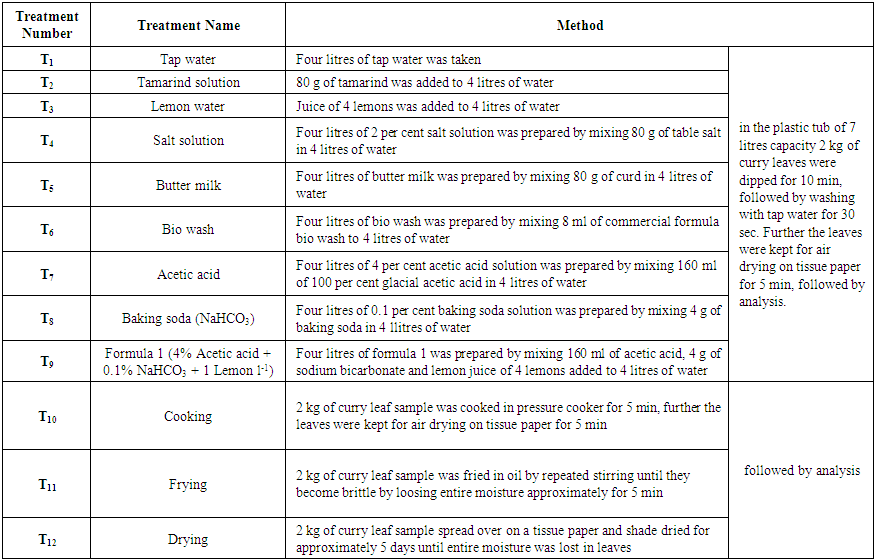 | Table 1. Decontamination methods used in the study or risk mitigation methods |
 Sample extraction procedureCurry leaf samples were collected from the fields sprayed with insecticides and brought to the laboratory and analyzed for pesticide residues following the AOAC official method 2007.01 (QuEChERS) after validation of the method in the laboratory. Each sample was homogenized separately with robot coupe blixer and homogenized 15 ± 0.1 g sample was taken in 50 ml centrifuge tube and 30±0.1 ml acetonitrile was added to sample tube. The sample was homogenized at 14000-15000 rpm for 2-3 min using Heidolph silent crusher. 3±0.1 g sodium chloride was added to sample, mixed thor oughly by shaking gently followed by centrifugation for 3 min at 2500-3000 rpm to separate the organic layer. The top organic layer of about 16 ml was taken into the 50 ml centrifuge tube and added with 9±0.1 g anhydrous sodium sulphate to remove the moisture content. 8 ml of extract was taken in to 15 ml tube, containing 0.4±0.01 g PSA sorbent (for dispersive solid phase d-SPE cleanup), 1.2 ±0.01 g anhydrous magnesium sulphate and 0.05 g of GCB (graphatised carbon black).The sample tube was vortexed for 30 sec then followed by centrifugation for 5 min at 2500-3000rpm. The extract of about 1 ml (0.5 g sample) was taken for analysis on LCMS/MS under standard operational conditions (Table 2).
Sample extraction procedureCurry leaf samples were collected from the fields sprayed with insecticides and brought to the laboratory and analyzed for pesticide residues following the AOAC official method 2007.01 (QuEChERS) after validation of the method in the laboratory. Each sample was homogenized separately with robot coupe blixer and homogenized 15 ± 0.1 g sample was taken in 50 ml centrifuge tube and 30±0.1 ml acetonitrile was added to sample tube. The sample was homogenized at 14000-15000 rpm for 2-3 min using Heidolph silent crusher. 3±0.1 g sodium chloride was added to sample, mixed thor oughly by shaking gently followed by centrifugation for 3 min at 2500-3000 rpm to separate the organic layer. The top organic layer of about 16 ml was taken into the 50 ml centrifuge tube and added with 9±0.1 g anhydrous sodium sulphate to remove the moisture content. 8 ml of extract was taken in to 15 ml tube, containing 0.4±0.01 g PSA sorbent (for dispersive solid phase d-SPE cleanup), 1.2 ±0.01 g anhydrous magnesium sulphate and 0.05 g of GCB (graphatised carbon black).The sample tube was vortexed for 30 sec then followed by centrifugation for 5 min at 2500-3000rpm. The extract of about 1 ml (0.5 g sample) was taken for analysis on LCMS/MS under standard operational conditions (Table 2).
|
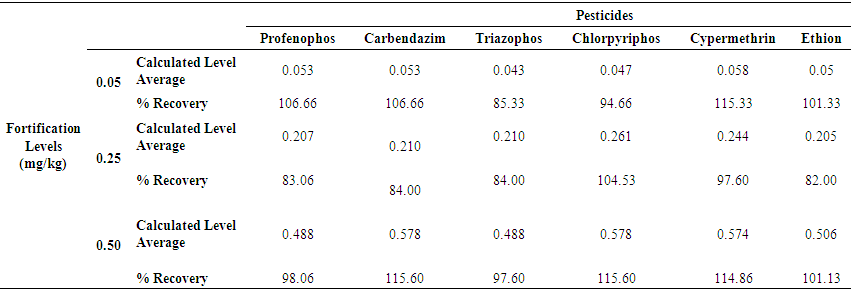 | Table 3. Recoveries of Profenofos, carbendazim, Triazophos, Chlorpyriphos, Cypermethrin and Ethion at various fortification levels in curryleaf samples |
3. Results and Discussion
- The residues of, Triazophos, Chlorpyriphos, Ethion, Carbendazim, Cypermethrin and Profenofos in curryleaf samples have got substantial reduction by different house hold processing methods. The reduction percentage and residue levels are presented in Table 4 and depicted in Fig 1.
 | Table 4. Effectiveness of various decontamination methods |
 | Figure 1. Per cent removal of pesticide residues from curry leaf by various decontamination methods |
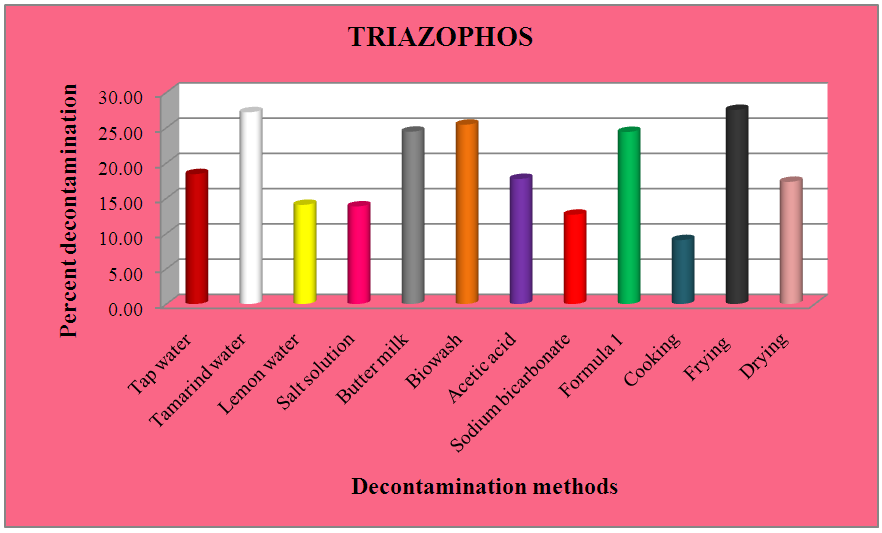 | Figure 2. Per cent removal of triazophos residues from curry leaf by various decontamination methods |
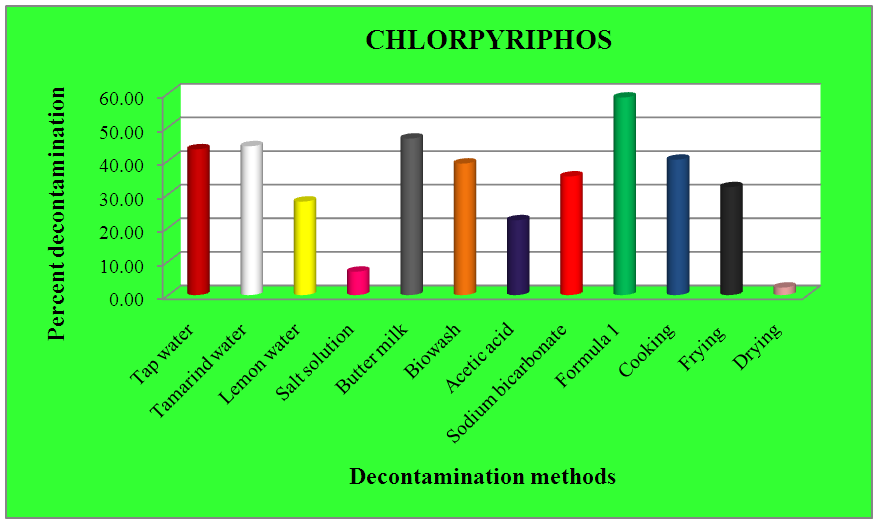 | Figure 3. Per cent removal of chlorpyriphos residues from curry leaf by various decontamination methods |
 | Figure 4. Per cent removal of ethion residues from curry leaf by various decontamination methods |
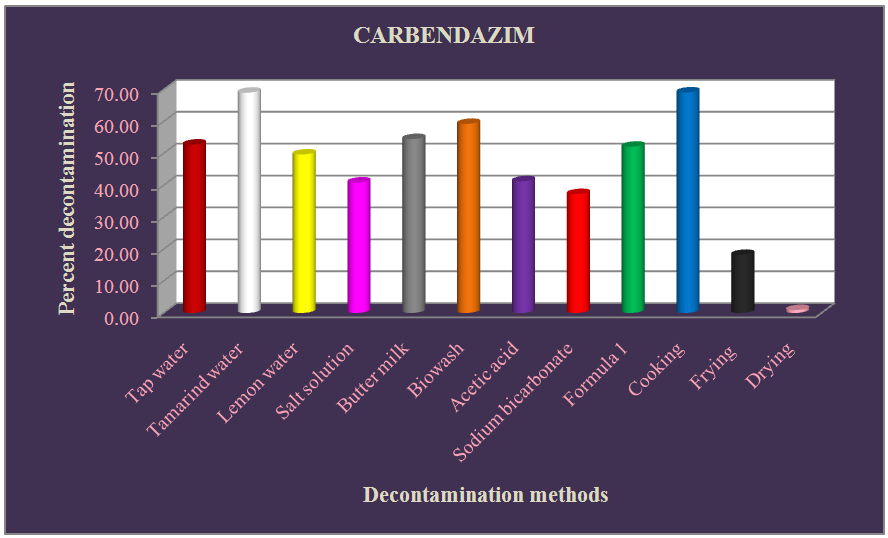 | Figure 5. Per cent removal of carbendazim residues from curry leaf by various decontamination methods |
 | Figure 6. Per cent removal of cypermethrin residues from curry leaf by various decontamination methods |
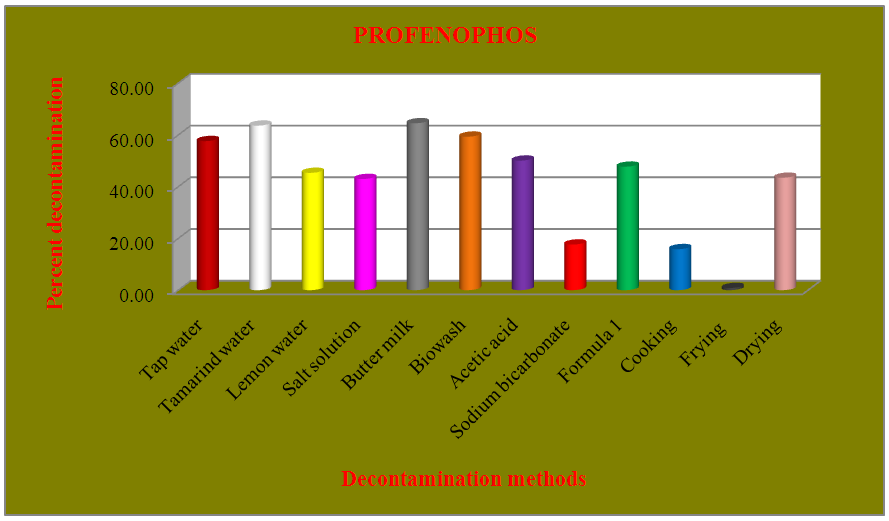 | Figure 7. Per cent removal of profenophos residues from curry leaf by various decontamination methods |
 Abstract
Abstract Reference
Reference Full-Text PDF
Full-Text PDF Full-text HTML
Full-text HTML